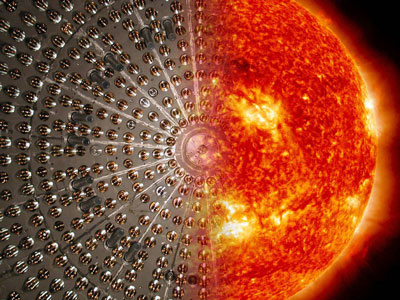| Aug 28, 2014 |
Physicists observe the creation of solar energy for the first time ever
|
|
(Nanowerk News) For the first time in the history of solar research, scientists have successfully measured solar energy at the instant of creation inside the sun. In the Gran Sasso underground laboratory, physicists of the Borexino Collaboration are for the first time ever directly observing the neutrinos created during the fusion of two hydrogen nuclei and the resultant production of heavy hydrogen. The researchers, including physicists from the Technische Universität München (TUM), are presenting their results in the current issue of Nature ("Neutrinos from the primary proton–proton fusion process in the Sun").
|
|
15 million degrees Celsius – that is the temperature deep inside our sun. Various fusion reactions take place there. 99 percent of the energy is created in a fusion cycle that starts with two hydrogen atoms fusing into a single atomic nucleus of heavy hydrogen. The energy that lets the sun shine (solar radiation) is released in this cycle. In addition, electrically neutral particles called neutrinos are created.
|
 |
| The photo shows the Borexino-Detektor and the sun. (Photo: Borexino Collaboration)
|
|
Radiation doesn’t reach the surface for over a hundred thousand years
|
|
Previous analyses of solar energy built on measurements of solar radiation. On average, however, this takes over one hundred thousand years to find its way to the surface from the sun’s dense core. That means the calculated values correspond to the energy that was released over a hundred thousand years ago inside the sun.
|
|
Neutrinos behave in a completely different manner: As electrically neutral elementary particles, neutrinos hardly interact with other matter, allowing them to move freely. They thus leave the interior of the sun within seconds of their creation and reach the Earth in only eight seconds – more or less at the speed of light.
|
|
However, the same properties that enable neutrinos escape from the interior of the sun so quickly, also make these particles from the decisive nuclear reactions in the sun extremely difficult to measure. "The published observation was possible only because Borexino is the most sensitive detector worldwide and we were able to massively reduce noise from radiation and other cosmic particles," says Prof. Stefan Schönert. "In addition to solar neutrinos, we can also observe neutrinos from the interior of the Earth and use them to test geophysical models," adds Prof. Lothar Oberauer. Both scientists work at the TUM Chair for Experimental Physics and Astroparticle Physics.
|
|
Energy released in the sun’s interior unchanged for ages
|
|
These latest results provide, for the first time, experimental proof that the energy released from inside the sun has remained unchanged for a very long time. To this end the researchers compared the present values of solar energy measured using the new methodology with the solar energy from over one hundred thousand years ago measured via the solar radiation. The result of the comparison correlates well with current theoretical models of the sun.
|
|
The scientists of the Borexino Collaboration have further ambitious plans: In the next four years they hope to improve the previously made measurements and to carry out new neutrino observations. One experiment in particular is currently in preparation to search for new particles – so-called sterile neutrinos. Their existence would have fundamental repercussions for particle physics, astrophysics and cosmology.
|
|
About the project
|
|
The Borexino experiment is installed in the Italian Gran Sasso underground laboratory approximately 1400 meters beneath the surface of the Earth and serves primarily for the observation of neutrinos. Borexino is a cooperation of scientists from Italy, Germany, France, Poland, USA and Russia. Germany is represented with groups from Technische Universität München, the Max-Planck Institute for Nuclear Physics in Heidelberg, the Universty of Mainz, the University of Hamburg, and the Technische Universität Dresden. One of the Authors and co-initiator of the Borexino Experiment is TUM Professor Emeritus Franz von Feilitsch, who founded the Collaborative Research Center "Astrophysics" in 1994 in which the Borexino Experiment assumed a central role.
|

